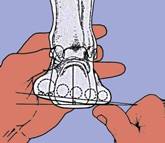Forefoot Varus or Forefoot Supinatus?
Forefoot varus is a fixed, frontal plane deformity where the forefoot is inverted with respect to the rearfoot. Forefoot varus is normal in early childhood, but should not persist past 6 years of age (i.e. when developmental valgus rotation of forefoot on rearfoot is complete, and plantar aspects of fore- and rearfoot become parallel to, and on same plane as, one another (1)
Forefoot supinatus is the supination of the forefoot that develops with adult acquired flatfoot deformity. This is an acquired soft tissue adaptation in which the forefoot is inverted on the rearfoot. Forefoot supinatus is a reducible deformity. Forefoot supinatus can mimic, and often be mistaken for, a forefoot varus. (2)
A forefoot varus differs from forefoot supinatus in that a forefoot varus is a congenital osseous where a forefoot supinatus is acquired and develops because of subtalar joint pronation.
“Interestingly, only internal rotation of the hip was increased in subjects with FV – no differences were present in hip adduction and knee abduction between subjects with and without FV. The authors nevertheless conclude that FV causes significant changes in mechanics of proximal segments in the lower extremity and speculate that during high-speed weight-bearing tasks such as running, the effects of FV on proximal segments in the kinetic chain might be more pronounced.”
We wonder if the folks in this study had a true forefoot varus, or actually a forefoot supinatus (3).
The Gait Guys
1. Illustrated Dictionary of Podiatry and Foot Science by Jean Mooney © 2009 Elsevier Limited.
2. Evans EL1, Catanzariti AR2. Forefoot supinatus.
Clin Podiatr Med Surg. 2014 Jul;31(3):405-13. doi: 10.1016/j.cpm.2014.03.009.
3. Scattone Silva R1, Maciel CD2, Serrão FV3. The effects of forefoot varus on hip and knee kinematics during single-leg squat. Man Ther. 2015 Feb;20(1):79-83. doi: 10.1016/j.math.2014.07.001. Epub 2014 Jul 12.






















